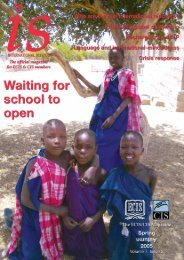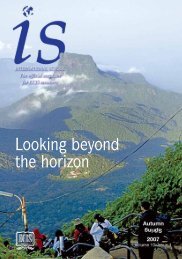is magazine 8.1 - Autumn/Spring 2005 - International Schools ...
is magazine 8.1 - Autumn/Spring 2005 - International Schools ...
is magazine 8.1 - Autumn/Spring 2005 - International Schools ...
You also want an ePaper? Increase the reach of your titles
YUMPU automatically turns print PDFs into web optimized ePapers that Google loves.
<strong>is</strong> <strong>Autumn</strong> <strong>2005</strong><br />
<strong>Spring</strong><br />
Creating an international culture<br />
Creating an<br />
international culture<br />
Sencer Corlu examines enculturation, the<br />
phenomenon that affects students as well as teachers<br />
Teaching in international schools <strong>is</strong> unique in many ways. Living<br />
abroad, having students from all over the world or working with<br />
colleagues from different regions of the planet are superficial<br />
aspects of a more complex phenomenon.<br />
Research conducted on educators teaching students from<br />
diverse cultures argues that ‘there are cultural traditions and systemic<br />
features, which necessitate a period of “enculturation”<br />
before teachers can expect to become effective’ (Pepin, 1998).<br />
However, in an international school, enculturation <strong>is</strong> not the concern<br />
of teachers only but also of the students.<br />
Moreover, th<strong>is</strong> enculturation period may be long and tough for<br />
both parties since the culture created in these communities <strong>is</strong><br />
unique for each and has no example in any other part of the world<br />
but in international organ<strong>is</strong>ations. It <strong>is</strong> a unique culture, emerging<br />
unnaturally from unnatural obligations.<br />
What all members of any international community share in<br />
common <strong>is</strong> the fact that the conditions are different from those<br />
they are used to. The expatriates have to survive under the influence<br />
of at least three cultures: their own culture, international<br />
culture of the school, and the culture of the country hosting them.<br />
Below are some suggestions to decrease the time needed for enculturation<br />
of teachers and students for a multicultural experience.<br />
Teachers find it difficult to suspend their own judgements about<br />
the way of doing things and it necessitates open-mindedness<br />
(Pepin, 1998), tolerance, and good observation skills. In MEF<br />
<strong>International</strong> School, teachers are encouraged to record daily any<br />
noteworthy incident that happened in their classroom. Personally,<br />
when I read my notes at the end of the day, they very much help<br />
‘What all members of any international<br />
community share in common <strong>is</strong> the fact that the<br />
conditions are different from those they are<br />
used to.’<br />
me to reconsider the way I handle unfamiliar situations and<br />
increase my flexibility in new unfamiliar ones.<br />
Murthadra-Watts and D’Ambrosio suggest teachers share their<br />
life stories and experiences in order to re-evaluate their own<br />
habitual teaching patterns (1997). Th<strong>is</strong> sharing may occur via the<br />
Internet in teacher forums or as one of my colleagues does, by publ<strong>is</strong>hing<br />
an interactive journal using YahooGroups.<br />
In Irmak School, where I used to teach, at the end of each<br />
monthly curriculum and interd<strong>is</strong>ciplinary planning meeting, we<br />
divided into small groups to talk and d<strong>is</strong>cuss our practices. It was<br />
very much like a therapy group, where teachers talk about our current<br />
and previous teaching experiences. Even writing an essay<br />
about our teaching philosophy and adding it to the teacher portfolio<br />
may be a small step to analyse the way we teach and hopefully<br />
to reformulate our methods for the unique needs of our students.<br />
These needs are indeed unique, obviously because of the different<br />
family, cultural, and educational background of students<br />
coming to school with different expectations. These expectations<br />
may vary diversely from teaching methodology to d<strong>is</strong>ciplinary<br />
methods.<br />
In addition to the above practices and the orientation programme<br />
organ<strong>is</strong>ed by the school, old-hands like the more experienced<br />
international teachers or teachers from the local community<br />
may help newcomers to overcome the challenges that<br />
Pepin (1998) grouped under two strands: ‘The cultural traditions<br />
and the structural constraints’.<br />
Social contact between students who have had little previous<br />
contact needs to be positive. Bennet (2001) talks of four<br />
29




